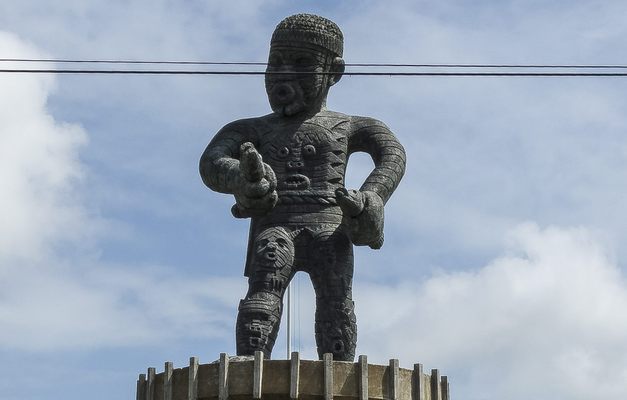About
The 1763 Monument proudly stands in the Square of the Revolution in the Guyanese capital of Georgetown. Unveiled in 1976, it commemorates the Berbice Slave Rebellion of 1763, a major event in Guyana's anti-colonial struggles.
On February 23, 1763, a slave revolt broke out in the Dutch colony of Berbice in what is now Guyana. At the time, the colony consisted of approximately 350 white colonists, 250 enslaved indigenous people, and almost 4,000 black enslaved people. Should a rebellion gain any traction, the colonial rulers would therefore find themselves in no small amount of trouble. And that’s exactly what happened.
The uprising began on the Magdalenenberg Plantation, in protest of the inhumane treatment of the enslaved people by their colonial masters. The main house and outbuildings were torched, and the rebels moved on to one plantation after another, liberating other enslaved Africans who then joined the spreading rebellion.
At the Lilienburg Plantation, a house enslaved person named Cuffy (variously Coffy, Kofi or Koffi) of West African origin joined the revolt. He became the leader of the rebellion, training the rebel forces to fight as a unit against the Dutch militia. He took the wife of the manager of Plantation Bearestyn as his wife, and soon declared himself Governor of Berbice.
Despite taking control of Berbice, Cuffy and the rebellion were ultimately undone by internal conflict. Cuffy had selected a man named Akara as his deputy, but Akara was a more aggressive leader and disapproved of Cuffy’s attempts to establish a truce and make terms with the Dutch. Akara formed a group to oppose Cuffy, and when Cuffy lost he took his own life. About a year after the start of the rebellion, troops from neighboring French and British colonies arrived to assist the Dutch and the rebellion was defeated.
Despite this defeat, Cuffy became a national hero of Guyana, and a symbol of the fight against colonial powers. In 1976, to celebrate the tenth anniversary of Guyana’s independence, a statue of Cuffy was unveiled on the Square of the Revolution in the Guyanese capital of Georgetown. The statue is officially called the 1763 Monument, but is often referred to as the Cuffy Monument.
The statue, which stands at 15 feet tall and weighs two and a half tons, was designed by Guyanese sculptor Philip Moore and cast in England by the Morris Singer Foundry.
The figure of Cuffy bears many symbols: his pouting mouth is a sign of defiance; the face on his chest is a symbolic breastplate giving protection in battle; and the horned faces on his thighs represent revolutionaries from Guyanese history, including Quamina from the Demerara rebellion of 1823. In his hands he holds a pig and a dog, each being throttled, the pig representing ignorance, and the dog covetousness and greed.
Know Before You Go
The 1763 Monument is located in the Square of the Revolution in the center of Georgetown, between Homestretch Avenue, Vlissingen Road and Hadfield Street.
Community Contributors
Added By
Published
November 19, 2018
Sources
- http://www.guyana.org/features/guyanastory/chapter30.html
- https://blackthen.com/berbice-slave-uprising-1763/
- https://www.stabroeknews.com/2013/news/guyana/02/27/the-1763-monument/
- http://nationaltrust.gov.gy/1763-monument/
- https://www.kaieteurnewsonline.com/2013/07/28/cuffy-a-symbol-of-struggle-and-freedom/
- https://face2faceafrica.com/article/meet-cuffy-the-west-african-slave-who-led-a-1763-revolt-that-made-him-a-guyanese-hero













